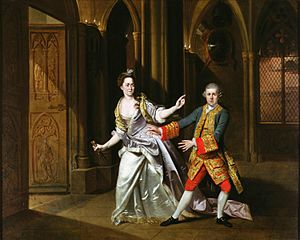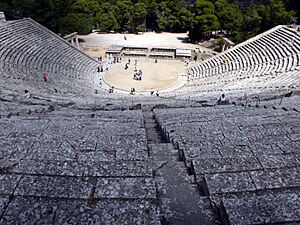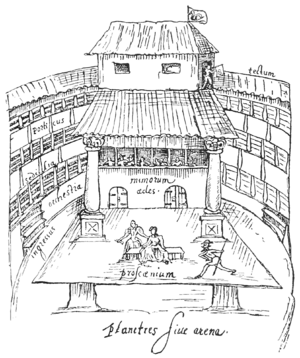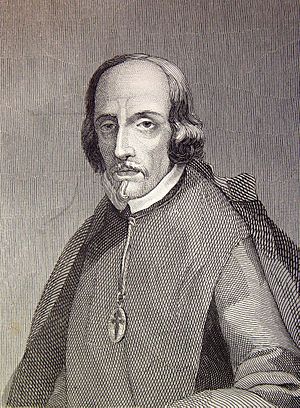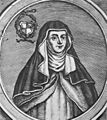History of theatre facts for kids
The history of theatre explores how plays and performances have grown and changed over the last 2,500 years. While people have always performed in different ways, theatre as an art form is special. It started in ancient Athens around 500 BC and has since become a lively tradition in cultures all over the world.
Contents
How Theatre Began
Many historians believe that theatre might have grown out of ancient rituals. These rituals often had exciting parts, like special costumes and masks, and skilled performers. As societies became more complex, these performance elements started to be used for entertainment, separate from religious ceremonies. This was an important step towards theatre becoming its own art form.
European Theatre History
Ancient Greek Theatre
Greek theatre, especially in Athens, is where Western theatre began. The word "theatre" itself comes from Greek! It was a big part of Greek life, including festivals, religious events, and even politics. Being an audience member at festivals like the City Dionysia was an important part of being a citizen.
Ancient Greek theatre had three main types of plays:
- Tragedy: These were serious plays, often about heroes facing difficult challenges or sad fates. They sometimes included singing and dancing. Only a few tragedies from the 5th century BC have survived, written by famous playwrights like Aeschylus, Sophocles, and Euripides.
- Comedy: These plays were funny and often made fun of people or ideas. The most famous writer of Old Comedy was Aristophanes.
- Satyr Play: These were short, funny plays performed after a series of tragedies, often making light of serious myths.
Roman Theatre

Theatre grew a lot under the Romans. The Romans first saw theatre performances by Etruscan actors in the 4th century BC. Roman theatre was very diverse, from street theatre and acrobatics at festivals to comedies by Plautus and serious tragedies by Seneca.
As the Roman Empire grew, theatre spread across Europe. While Greek plays were still performed, Roman theatre started to focus on different kinds of entertainment. The first important Roman plays were written around 240 BC by Livius Andronicus and Gnaeus Naevius.
The Roman comedies that we still have today were written by Plautus and Terence. These plays were based on Greek stories but were changed to fit Roman tastes. They often featured musical parts and scenes set on a street, where characters might overhear secrets. Plautus was known for his witty dialogue and farces, while Terence was known for his complex plots.
Unlike Greek theatre, Roman theatre allowed women to perform. Many were dancers and singers, but some actresses became famous for speaking roles and even formed their own acting groups.
Theatre in the Middle Ages (500–1500 AD)
When the Western Roman Empire declined, theatre in Western Europe mostly disappeared. Small groups of performers traveled around, but there's not much evidence of complex plays. The Church often saw these performers as dangerous.
However, churches later started staging short plays based on Bible stories, especially for holidays like Easter. These were called liturgical dramas. They helped teach the stories to people who couldn't read.
A German nun named Hrosvitha (around 935–973) wrote six plays based on Roman comedies but with religious themes. She is the first known female playwright after ancient times.
As towns and trade grew, theatre moved outside the churches. Plays were translated into everyday languages and performed by regular people, not just priests. These were often Mystery plays, which told Bible stories in long cycles. Many of these plays included funny parts, devils, and clowns.
Actors were usually local people. In England, only men performed, but in other countries, women also took part. Plays were often performed on pageant wagons, which were like movable stages.
Around 1400, a new type of play called a Morality play became popular. These plays taught moral lessons, often showing a character's journey from birth to death. The most famous one is Everyman, where the main character faces Death and is deserted by friends and possessions, with only Good Deeds staying with him.
Secular (non-religious) plays also existed, like The Play of the Greenwood by Adam de la Halle (1276), which included satire and magical creatures. Funny plays called Farces also became very popular, especially in France and Germany.
By the end of the Middle Ages, professional actors started to appear. Kings like Richard III and Henry VII had their own small groups of actors. Plays were performed in large halls.
Medieval drama ended for several reasons, including the weakening power of the Catholic Church and the Protestant Reformation. Many countries banned religious plays. This forced theatre to become more secular and led to new forms of drama, often inspired by ancient Greek and Roman theatre.
Italian Commedia dell'arte and Renaissance Theatre

Commedia dell'arte was an early form of professional theatre that started in Italy and was popular across Europe from the 16th to 18th centuries. It was known for its masked characters and improvised performances based on simple stories.
A special part of Commedia was the lazzo, which was a funny joke or routine that actors knew well. Another key feature was pantomime, especially used by the character Harlequin.
The characters in Commedia were often fixed social types, like foolish old men, tricky servants, or boastful soldiers. They were exaggerated versions of real people, such as the greedy old man Pantalone or the know-it-all doctor Il Dottore. Many acting groups were formed to perform Commedia, often outdoors in town squares.
Commedia dell'arte was important because it allowed professional women to perform on stage early on. Actresses like Lucrezia Di Siena and Vincenza Armani became well-known.
English Elizabethan Theatre
English Renaissance theatre grew from medieval traditions like mystery plays and morality plays. It was also influenced by Italian Commedia dell'arte and elaborate court shows called masques.
Before Queen Elizabeth I, groups of actors were linked to noble families and performed plays. These groups became the first professional actors on the Elizabethan stage. A law in 1572 made it illegal for actors to perform without official support, calling them vagabonds (homeless wanderers).
London officials didn't like public theatre, but Queen Elizabeth loved plays, so theatres were built in areas outside the city's control, like Southwark. The actors pretended their public shows were just rehearsals for the Queen, but the public performances were their main source of income.
Over time, the type of plays changed. Under Elizabeth, everyone, from the Queen to commoners, watched the same plays. Later, with the rise of private theatres, plays became more focused on the tastes of upper-class audiences.
In 1642, when the English Civil War began, Puritan leaders banned all plays in London. They believed theatre was immoral and pagan. This ban stopped the English dramatic tradition for a while.
Spanish Golden Age Theatre
During Spain's Golden Age (roughly 1590 to 1681), theatre became incredibly popular. It was enjoyed by everyone, from nobles who sponsored it to common people who attended shows. Spain produced an amazing number of plays during this time, far more than England. Many of these plays are still considered masterpieces.
Key playwrights included Lope de Vega, who wrote a huge number of plays, and Calderon de la Barca, who invented the zarzuela (a Spanish musical play).
Spanish theatre was influenced by Italian Commedia dell'arte and local traveling performers. In turn, Spanish drama had a big impact on theatre in England and across the Spanish-speaking world.
French Classical Theatre
In the 17th century, France saw the rise of "Classical theatre," known for its strict rules and focus on logic and order. Important playwrights from this period include:
- Pierre Corneille (1606–84)
- Molière (1622–73)
- Jean Racine (1639–99)
Restoration Comedy
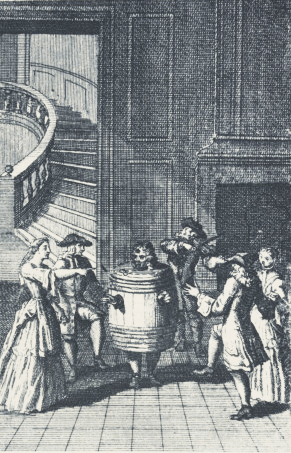
After 18 years of theatre being banned by the Puritan government, the reopening of theatres in 1660 marked a new era for English drama. Plays written between 1660 and 1710 are called "Restoration comedy." These comedies were known for being a bit scandalous, a style encouraged by King Charles II.
For the first time, women were allowed to act on stage, ending the tradition of boys playing female roles. Audiences were diverse, including nobles, servants, and middle-class people. These plays often showed the love lives of young, fashionable characters, with a happy ending for the main couple. Heroines were often clever and outspoken. This period also saw the first professional woman playwright, Aphra Behn.
Later, as a reaction to the wildness of Restoration comedy, "sentimental comedy" became popular. These plays focused on showing good behavior and middle-class characters overcoming moral challenges. Playwrights like Colley Cibber and Richard Steele believed that humans were good at heart and could be improved through theatre.
Nineteenth-Century Theatre
The 19th century in theatre had two main parts:
- Early Period: This time was dominated by melodrama and Romanticism. Melodrama, which started in France, became very popular. These plays often had clear heroes and villains, exciting plots, and emotional music. In Germany, there was a focus on historical accuracy in costumes and sets, and a new style called German Romanticism emerged, inspired by a growing sense of national pride.
- Later Period: This period saw the rise of two opposing styles: realism and non-realism (like Symbolism). Realism aimed to show life as it truly was, with ordinary characters and everyday problems. This started in Russia with playwrights like Ivan Turgenev and Aleksandr Ostrovsky. It led to the creation of the Moscow Art Theatre.
In Germany, the Meiningen Ensemble was famous for its historically accurate productions. They were among the first to focus on the overall vision of the director, rather than just the actors.
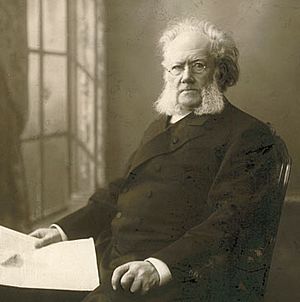
A very important playwright was Henrik Ibsen from Norway. He wrote plays like A Doll's House and Ghosts, which explored deep psychological themes and are considered foundational to modern realistic drama. His work paved the way for other British playwrights like George Bernard Shaw and Oscar Wilde.
Twentieth-Century Theatre
The 20th century saw theatre continue to develop realism, but also many new, experimental styles. These experiments were part of modernist and postmodernist movements. They included political theatre and more artistic works like:
- Epic theatre: Developed by Bertolt Brecht, it aimed to make audiences think critically, not just feel emotions.
- Theatre of Cruelty: Proposed by Antonin Artaud, it sought to shock audiences into confronting their deepest fears and desires.
- Theatre of the Absurd: Plays that showed life as meaningless or illogical, with famous examples by Samuel Beckett and Eugène Ionesco.
The term "theatre practitioner" became common for someone who both creates theatre and develops theories about it. This includes directors, playwrights, and actors who combine these roles.
After the popularity of British musical comedies, American musical theatre became dominant, with famous composers like the Gershwin brothers, Cole Porter, and Rodgers and Hammerstein.
American Theatre
Early American Theatre (1752–1895)
American theatre has always been unique, reflecting the country's search for its own identity. The very first play performed in America was Shakespeare's "The Merchant of Venice" in 1752. However, due to strong Christian beliefs, theatre was banned from 1774 to 1789, as it was seen as frivolous. During the ban, plays were sometimes disguised as "moral lectures."
After the American Revolutionary War, theatre quickly restarted and spread westward. Many new theatres were community-run. Professional theatre companies, like Samuel Drake's, traveled to new towns along rivers, bringing performances to places like Ohio, Indiana, and Missouri.
Early American theatre was heavily influenced by Europe, as many actors were English-born and trained. Over time, the focus shifted from neoclassical philosophy to Romanticism, which often idealized the "noble savage." By the late 19th century, new acting methods led to the rise of realism.
Modern American Theatre (1895–1990)
In this era, the hero in plays became more like an ordinary person shaped by their surroundings. This change was partly due to the civil war, which made America lose some of its innocence.
Even though Hollywood movies became popular and seemed to threaten theatre, American theatre actually thrived and gained worldwide recognition. Playwrights like Tennessee Williams and Arthur Miller became globally famous during this period.
African Theatre
Ancient Egyptian Theatre
The earliest known theatrical events date back to 2000 BC in Ancient Egypt. These were "passion plays" that told the story of the god Osiris and were performed annually at festivals.
Modern Egyptian Theatre
Modern theatre in Egypt began to develop in the second half of the 19th century, influenced by European theatre. However, Egypt also had its own popular theatrical forms that existed for thousands of years.
Early figures like Yaqub Sanu and Abu Khalil Qabbani helped start this new era. Later, various theatre groups emerged, presenting both tragedies and comedies. Famous names include Youssef Wahbi (for tragedy) and Naguib El-Rihani (for comedy).
Many plays were performed in the 1930s and 1940s. The Rihani band was the longest-running private theatre group, active for 67 years. The Ramses Troupe was the most productive, staging over 240 plays. The National Theater Troupe, a state-run group, has been active for over 80 years.
After the 1952 revolution, new playwrights like Alfred Farag and Ali Salem emerged. Women also played a big role, with Mounira El Mahdeya becoming the first Egyptian singer and actress to found her own theatre group in the early 20th century. She even discovered the famous musician Mohammed Abdel Wahab. In the 1960s and 70s, movie stars started performing in plays, and comedy became very popular.
West African Theatre
Ghanaian Theatre
Modern theatre in Ghana started in the early 20th century. It often commented on Europe's colonization of Africa. For example, The Blinkards (1915) by Kobina Sekyi made fun of Africans who copied European culture.
Another important play is Anowa by Ama Ata Aidoo. It tells the story of Anowa, a woman who insists on choosing her own husband. The play highlights the need for gender equality and respect for women. Anowa supports her husband, Kofi, who becomes wealthy but loses his moral compass by using slaves. The play suggests women have a stronger moral sense in a male-dominated society.
The Marriage of Anansewa (1975) by Efua Sutherland is based on traditional Akan folk tales. The main character, Ananse (the spider), is cunning and selfish. He tries to marry his daughter to several rich chiefs at once to get money. The play uses Ananse to encourage self-reflection in the audience. It also includes audience participation through songs.
Yoruba Theatre
Yoruba theatre in Nigeria has roots in the masquerade of the Egungun (ancestor worship). During these ceremonies, it was believed that ancestors returned to visit their descendants.
The Aláàrìnjó theatrical tradition started in the 16th century. These were traveling performers who wore masks and created short, funny scenes with stereotypical characters. They used mime, music, and acrobatics. This tradition influenced the popular traveling theatre in Nigeria from the 1950s to the 1980s, which later moved into television and film.
"Total theatre" also developed in Nigeria in the 1950s, using non-realistic techniques and flexible language. Playwrights like Hubert Ogunde and Wole Soyinka (considered Africa's greatest living playwright) have been greatly influenced by traditional Yoruba performance styles.
African-American Theatre
The history of African-American theatre began in two ways: through local performances in cabins and parks, where African Americans shared folk tales, songs, and dances rooted in African culture, and through formal theatre. The African Grove Theatre, established in 1821 by William Henry Brown, was the first African-American theatre.
Asian Theatre
Indian Theatre
Ancient Indian Theatre
The earliest form of Indian theatre was Sanskrit theatre, which flourished between the 1st and 10th centuries AD. Hundreds of plays were written during this peaceful period. Ancient texts like the Rigveda show evidence of plays being performed during ceremonies, with dialogues ranging from one to three characters.
The A Treatise on Theatre (Nātyaśāstra), written between 200 BC and 200 AD, is the most complete book on theatre from the ancient world. It covers everything from acting and dance to costumes and make-up. Sanskrit theatre was performed on sacred ground by trained priests. Its goal was to both educate and entertain.
Performers worked in professional groups led by a stage manager. There were no rules against female performers; groups could be all-male, all-female, or mixed. Actors were rigorously trained in both vocal and physical techniques.
Kālidāsa (1st century BC) is considered ancient India's greatest Sanskrit dramatist. His romantic play Abhijñānaśākuntala is very famous and was the first to be translated into English and German.
Traditional Indian Theatre
Kutiyattam is the only surviving form of ancient Sanskrit theatre, recognized by UNESCO as a "Masterpiece of the Oral and Intangible Heritage of Humanity." Many other forms of Indian folk theatre also exist:
- Bhavai: A popular folk theatre from Gujarat, dating back to the 14th century.
- Jatra: Popular in Bengal, its origins are linked to a religious movement in the 16th century.
- Swang: A dialogue-focused form from northern India, popular since the late 18th century.
- Yakshagana: A popular theatre art in Karnataka, existing since the 16th century. It's semi-classical, with music, songs, rich costumes, and stories from the Mahabharata and Ramayana.
- Kathakali: A highly stylized dance-drama from Kerala, developed in the 17th century. It's known for its elaborate make-up, costumes, and detailed gestures.
Modern Indian Theatre
Rabindranath Tagore was a pioneering modern playwright who wrote plays in Bengali that explored themes like nationalism, identity, and greed. His famous plays include The Post Office and Red Oleander.
Chinese Theatre
Early Chinese Theatre
Theatre in China dates back to 1500 BC during the Shang dynasty, often including music, clowning, and acrobatics.
During the Han dynasty, shadow puppetry became a recognized form of theatre. There were two main styles: Cantonese (southern) and Pekingese (northern). Cantonese puppets were larger and made of thick leather, while Pekingese puppets were smaller, made of thin, colorful leather. Both styles told stories of adventure and fantasy. Shadow puppetry reached its peak in the 11th century.
The Tang dynasty (618–907 AD) is sometimes called 'The Age of 1000 Entertainments'. Emperor Xuanzong even started an acting school called the Children of the Pear Garden for musical drama.
Later Chinese Theatre
In the Song dynasty, popular plays featured acrobatics and music. These developed into more complex four or five-act plays in the Yuan dynasty. Yuan drama spread across China and led to many regional forms, with Beijing Opera being the most famous and still popular today.
Indonesian Theatre
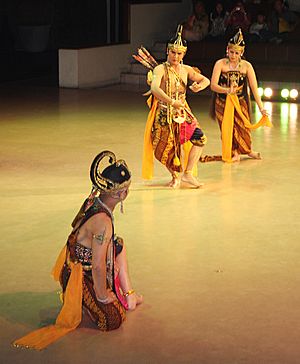
Indonesian theatre has a long history, often linked to local stories. Famous puppet theatres like wayang golek (wooden rod-puppet plays) and wayang kulit (leather shadow-puppet plays) often tell stories from the Indian epics Ramayana and Mahabharata.
These epics also inspire wayang wong (human theatre) in Java and Bali, where actors perform. Wayang wong is a classical Javanese dance performance. Ancient temples like Prambanan have carvings showing scenes from the Ramayana.
Khmer Theatre (Cambodia)
In Cambodia, at the ancient capital Angkor Wat, stories from the Indian epics Ramayana and Mahabharata are carved on the walls of temples and palaces, showing their influence on local storytelling and performance.
Thai Theatre
In Thailand, plays based on Indian epics have been a tradition since the Middle Ages. The theatrical version of Thailand's national epic, Ramakien (a version of the Indian Ramayana), is still very popular today.
Philippine Theatre
During 333 years of Spanish rule, the Philippines adopted Catholic religion and Spanish ways of life, which blended with local cultures. Today, dramatic forms influenced by Spain, like the komedya (a type of play), sinakulo (passion play), and sarswela (musical drama), are still performed in rural areas.
Japanese Theatre
Noh Theatre
Noh theatre developed in Japan during the 14th century. It combines pantomime and vocal performances. Zeami Motokiyo (1363–1443) was a key figure who refined this style. Noh has fascinated the Japanese for hundreds of years with its unique blend of movement and sound.
Bunraku (Puppet Theatre)
After a long period of civil wars, Japan became unified and peaceful. This led to a flourishing of culture. Ningyō jōruri, commonly known as Bunraku, was the first theatre form to thrive. Chikamatsu Monzaemon (1653–1725) turned this puppet theatre into a true art form.
Bunraku uses large puppets, about one-third the size of a human. Master puppeteers, who train their whole lives, control the puppet's head and right arm and show their faces. Other puppeteers, who control less important parts, wear black suits to appear invisible. A single person performs all the dialogue, using different voices for each character.
Kabuki Theatre
Kabuki began shortly after Bunraku, supposedly started by an actress named Okuni around the end of the 16th century. Much of Kabuki's material came from Noh and Bunraku. It is less formal than Noh but very popular. Kabuki actors are trained in dancing, singing, pantomime, and acrobatics.
Kabuki was first performed by young girls, then young boys, and by the end of the 16th century, all Kabuki companies were made up of men. Men who played women's roles were specially trained to capture the essence of a woman through subtle movements.
Butoh Dance Theatre
Butoh is a diverse style of Japanese dance and performance that emerged after World War II. It often involves playful and strange images, taboo topics, and extreme settings. Performers traditionally use white body makeup and slow, controlled movements. Butoh was a reaction against traditional dance in Japan, which its founders felt was too superficial.
Turkish Theatre
The first mention of theatre plays in the Ottoman empire is linked to the arrival of Spanish Jews in the late 15th and 16th centuries. Later, other groups like Roma, Greeks, and Armenians became involved. The Orta oyunu, a Turkish version of Commedia dell'arte, became very popular across the Empire.
Persian Theatre
Medieval Islamic Theatre
The most popular forms of theatre in the medieval Islamic world were puppet theatre (including hand puppets, shadow plays, and marionettes) and live passion plays called ta'ziya. Ta'ziya plays often re-enacted stories from Muslim history, especially the martyrdom of Ali's sons, Hasan ibn Ali and Husayn ibn Ali.
Images for kids
-
Refinement meets burlesque in Restoration comedy. In this scene from George Etherege's Love in a Tub (1664), musicians and well-bred ladies surround a man who is wearing a tub because he has lost his trousers.
-
An 18th-century Neoclassical theatre in Ostankino, Moscow
-
Richard Wagner's Bayreuth Festival Theatre.
-
Wayang Wong theatre performance near Prambanan temple complex
See also
 In Spanish: Historia del teatro para niños
In Spanish: Historia del teatro para niños


